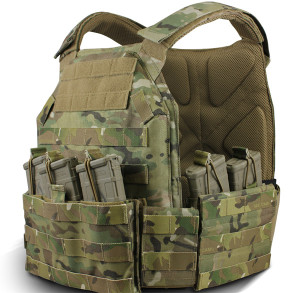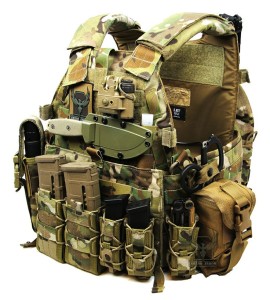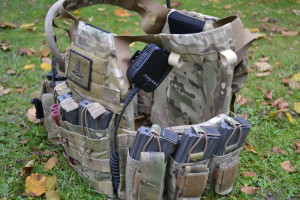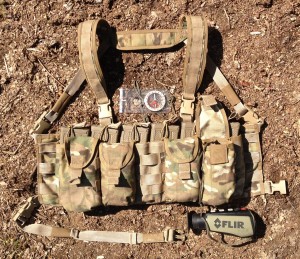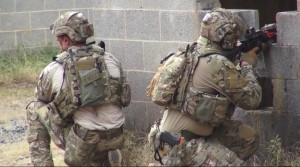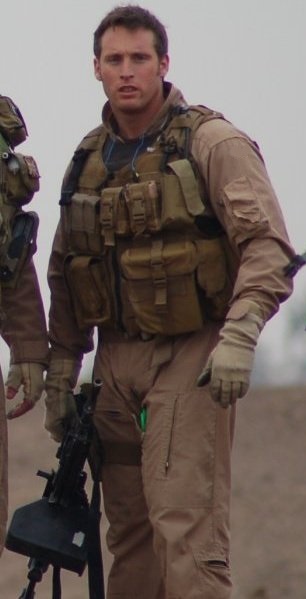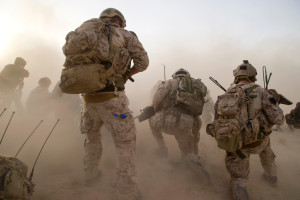Ballistic Plates: Yes or No?
The purpose of this post is to discuss the use of ballistic plates as part of your loadout gear. This tends to be a polarizing topic but it really shouldn’t be – it is more aptly about assessing threat / benefit alongside the balance of firepower / protection / mobility. Also, we are discussing this primarily for the purpose of a civilian audience and therefore it is not simply the case of procurement of a type of gear, and employment thereafter. Equipment costs money, and therefore there is a cost / benefit analysis to be done.
(NOTE: all images are pulled from Google, unless otherwise captioned)
So let’s look at some of the factors here:
- If we employ ballistic plates in a Plate Carrier, they are likely to be 10″ x 12″ size and thus likely to only cover that portion of the front and rear of your body. You can increase that coverage with smaller side plates, thus increasing weight. Plate Carriers (PC’s) also provide the best protection when the carrier is upright, and thus provide less utility when the wearer is prone, although this is balanced against the fact that your profile is significantly reduced when prone, and thus you are less likely to be hit.
- A PC comes with a penalty in weight. This is the balance of protection vs. mobility. You can reduce this penalty by spending more money, and thus getting lighter weight plates. This becomes a balance between what you can spend to get a lighter plate that has the highest level of protection. You may end up with a lighter plate that is level III, not level IV, and thus will (for example) not stop M855 Green Tip. Is there therefore no point in wearing the plates? It won’t stop .50 Cal either, so it is balance between what you can (or are willing) to spend and what level of protection / weight you will end up with.
- As well as the penalty in weight, a PC also covers up a significant part of your torso and thus traps heat. It is currently the height of the summer and thus the time when you are least likely to want to wear this gear. In the winter it is just weight, in the summer you will be a permanent sweat ball. However, you will be a permanent sweat ball whatever you wear in the summer, when outside without the benefit of AC. If you are going to wear body armor, you have to get used to being wet with sweat underneath it at all times. You can mitigate that by staying in the shade (also tactically beneficial for other reasons!) and carefully timing when you run any operations. This is also a planning factor in running night operations, something that will also cost you an investment in night vision gear and aiming lasers.
- There is no doubt that if you are facing a kinetic environment where people are shooting at you, it is beneficial to wear a PC. It doesn’t make you invincible, but it has the potential to significantly reduce the incidence of penetrating trauma to the torso. Always good! A PC validates itself the moment a round hits you in the plate. Simply ask yourself – if you had to go on a raid right now, and had a PC available, would you put it on?
- Because of the balance between mobility and protection, tactical fitness is a HUGE part of this. If you are training and considering even the outside chance that you may have to fight in a survival / combat environment, and you are not maximizing your tactical fitness, then you are living in a fantasy world. The ability to MOVE YOURSELF and your combat load in a combat environment is VITAL. If you are not sick or lame, and you have not reorganized your daily life so you can do some day to day fitness training, then you are living in denial and there is no point you reading any of this. The better your fitness is, the better you are able to deal with any survival situation, let alone combat. There is too much denial over this simple fact in the prepper/survivalist community.
- Given that you have now added the weight of plates to your loadout gear, you now have affected that balance between firepower / protection / mobility. You still have to carry the ammo, because ‘ammunition is time’ under enemy fire. The answer is to carry a realistic ammo load and to increase your PT so you can handle it. You want to have a philosophy of being as light as possible, but you have to understand that as, effectively, an infantryman, you will never be ‘light.’ You will have to carry a load on and about your person and you need to be able to move with it. We are not extras in ‘Falling Skies’ or ‘The Walking Dead,’ simply carrying an odd pouch or two or wearing some empty chest rig.
- Because you are a civilian prepper / survivalist you are able to make your own decisions independent of a corporate risk assessment. You may want to have a PC available but you may take a decision to not wear it all the time, given a decision making process balanced against the factors. What is the greater threat? Maybe you can’t afford a PC anyway, or some members of your group can’t? If the heat and task at hand are such that you are at risk of heat exhaustion, then maybe a PC is not a good idea? If you had to do an insertion march over hard terrain in the heat, and your fitness or the group was not up to it, then maybe ditch the PC’s? This is one of the reasons why the heavy steel ‘patriot plates’ are not a good idea – you are simply not mobile in them, particularly when balanced against the atrocious average state of fitness out there in the ‘community.’ However, if at the end of the approach march you had to go heavily kinetic into a raid, I would want to plan it so I would be wearing my PC for the raid. If instead the mission perhaps was an attack by fire or some form of snipe, or where the success depended on being able to move fast and ‘light’ (there’s that word again, and it ain’t true) then maybe the PC is more of a hindrance than a help and needs to be ditched? But here’s one thing: a PC is always a hindrance until you get hit in it, then it isn’t.
Ok, so we just covered some of the factors. Let’s look at practical use of the PC. There are many different ways to approach this. You may decide that a PC is what you are going to wear all the time, and thus it becomes part of the foundation of your gear loadout. Or you may decide that you want one available that will mesh with the rest of your gear. If you go for the former, there is no reason why you wouldn’t just festoon it with pouches, job done, there is your loadout gear. Then, you are stuck with the plates all the time. Make your own decision on how you want to roll with that. If you decide you will wear plates all the time, the PC becomes the basis of your gear, and everything then revolves around how to attach your gear to it.
I prefer a layered approach with gear. As a general background, in current times you want to be wearing a light belt under your concealment garment that holds your concealed handgun and spare mags, multitool etc. Once the situation steps up, I like to have a light external battle belt that holds various items such as: handgun, tourniquet, knife, 2 x rifle mags, 2 x handgun mags, folding dump pouch, small IFAK, multitool. This is the basis of my gear, it will be worn all waking hours, and I will either be carrying my rifle or it will be close at hand, or in the vehicle, dependent on the situation.
I think one of the issues is not knowing what any form of disaster or collapse will actually look like. I have often talked about making sound decisions as to what your ‘posture’ will be. It may not be the right time to roll out the multicammies. It may be a more ‘grey’ form of collapse where you are still moving about but facing higher threats/greater lawlessness than we face today. If you are able to carry a rifle and PC in your truck, perhaps with or without your lightweight battle belt, then you will deal with any initial situation with your concealed handgun, your everyday carry gear, and then if you get to the truck you have the option of the rifle and throwing on your PC. Most PC’s will take 3 x single stacked 5.56 magazines across the front. More if you also have pouches going to your sides around the cummerbund. If you are keeping a PC in your truck/house for self defense, but you are adopting the layered approach to your gear, it is useful to keep the PC fairly slick and run collapsible mag pouches on the front/sides. For example, some PCs come with integral single stack mag pouches, and/or you can get the elastic MOLLE pouches from Blue Force Gear that will collapse to nothing when there is no magazine in them. Thus, if you have the PC rigged simply with a basic ammo load but no extraneous pouches, it can be thrown on and used in a situation as referred to above, or the mags can be taken out so you can throw your chest rig over/on to the PC.
For my personal gear plan, once I am wearing my lightweight battle belt, my next layer is my chest rig. We are now offering the MVT VERSA CHEST RIG (Purchase here), which was designed to my specifications. The VERSA, just like the single caliber designs that are on the way, or most other chest rigs, can be worn with or without your PC. You can wear it without any PC underneath, or throw it on over the top. This is why a slick PC is advantageous if you are not sure you are going to want to wear it all the time. The VERSA also allows you to detach the h-harness and clip the VERSA directly to the front of your PC. This is the most versatile option, where you are able to wear the PC, or not, mission/situation dependent.
Above: MVT VERSA Chest Rig. 5.56 insert shown.
The ‘VERSA‘ name is due to the ability to exchange the magazine insert for different calibers of weapon.
Given the gear that you will need to carry on any form of patrol, ranging from a water bladder, to some food, spare magazines, TC3 items, and night vision gear/spare batteries, you will need to carry some form of assault/patrol pack. This is why I prefer my PC to not have any pouches on the back. I base this on the fact that I will pretty much always be wearing some form of assault/patrol pack, the size and weight of which will depend on the mission. If you see guys with pouches all over the back of their PC, they are probably set up for short term direct action missions with little requirement for a sustainment load of any sort.
Patrol packs are something I have talked about often before. If you are anywhere other than just fighting from your truck (where you will need a ‘bug out’ patrol pack to take with you) or around your house in a home defense situation, you will need to carry some load on your back, even just for water and some other basics. This is where the realistic balance of firepower / protection / mobility comes to the fore. No man is an island, and you will need resupply at some point. Other than some survival items, your load is seasonal dependent and short term. You will need to carry what you need for the mission, but try and steer clear of large rucks if at all possible. Now we really come back to the tactical fitness crunch. Don’t try and pack your ‘list of lists’ and your ‘two is one, one is none’ into whatever patrol pack you have. Particularly if you have decided to wear plates.
If I was to go on a local security patrol round my area, I would be wearing my battle belt, VERSA chest rig with or without my PC, and a small patrol/assault pack containing a 3L water bladder, spare magazines (at least 4), night vision gear (Crye nightcap to mount it to), spare batteries for all, some food (‘lunch’) and emergency rations / additional medical items (within reason). I would have some survival items in there such as water treatment / drinking items etc. This is the same small load that would be suitable if you, for example, found yourself as part of a resistance force fighting in an urban environment.
When it comes time to bug out to the ‘sticks’ and hide out / operate in a rural environment, then you need your sustainment load, to which you can attach the small assault pack of essential items (under the lid of the patrol pack). This pack in itself doesn’t want to be too big (45 liters approx.), but it contains essential sleeping items, more ammo, clothing, personal health/hygiene items etc. This can either go in a truck or may have to be carried, in which case none of this load should be beyond your physical capabilities.
I have said before that if you don’t have the physical ability to move in body armor, then you should not wear it. You need to build your skills and capabilities from the ground up. Begin with tactical fitness training, otherwise known as PT. Without this you will crumble, and be incapable of performing in a combat environment. Now, a lot of this comes down to intestinal fortitude. Not just the doing of day to day PT, but the performing in a combat environment. However, don’t think that ‘adrenalin’ will get you through on its own. If you are older or injured, don’t despair. You would think from reading some of my Student Reviews that an MVT training class is an Olympic event. It isn’t, but it requires some basic fitness and intestinal fortitude. I understand the comments though – students manned up, came and worked really hard, each to his/her own limit, and are rightly proud of their achievement. We have plenty of old guys show up, up to 70 years old, and they can get through it. It’s not really THAT hard, it just gets a little tiring being on your feet a lot and running lanes throughout the day. The main thing for these guys is not pure speed (like a 21 YO) but keeping the momentum up, with accurate sustained suppression and steady movement. We discourage over-fast movement at a sprint anyway, for learning and safety purposes.
As an aside on that, we have improved the medical at MVT beyond the preparations for potential trauma from a range accident. In discussion with a cardiac surgeon alumni, we agreed that the possibility of the most likely incident in training, given the age demographic of some of the students, is a cardiac one. He has now donated an AED and oxygen and we are improving the med bag accordingly. Excellent progress.
Once you are building your tactical fitness, you need training. This previous blog post ‘Buddy Position Awareness‘ highlights one of the huge issues that people who have only ever trained on a square range don’t get. Believe me, you need training. However high speed you used to be, you need training. We all do. You either can’t sit on your laurels, or if you have never done this before you need to get to a point where you have an understanding of small unit tactics and the dynamics of combat beyond shooting on line at the square range.
Once you are getting the fitness and training squared away, you can think about gear. Because the gear you bought on eBay probably isn’t the right stuff. As professionals we all go through gear evolution ourselves. Some students show up at Combat Team Tactics with really basic gear, on the basis that they will figure out what really works after they have run through the class. This is a good philosophy. It is also where you may figure out if wearing a PC is for you or not. It is probably where you will also find out that wearing those heavy steel plates is not a practical proposition (as they come off after a lane or two).
Because I have to tell you, wearing this gear takes effort. When you have it on, you will feel it. It doesn’t have to be uncomfortable, but you feel the weight of it. You have to be fit enough, and determined enough, to perform while wearing the gear necessary for the task. You need to strike that balance between firepower / protection / mobility. Personally, I feel the weight of my gear as a comfort, it’s a sort of psychological comfort blanket. Putting it on is part of the ritual as you contemplate the threats and visualize the mission.
Above: On contract as a paramilitary contractor in Iraq (Al Anbar) 2006.
Firepower is provided by the amount of ammo you can reasonably carry. In my opinion, you should not have less than 8 mags on your person plus the one in your weapon, with some extras on your back (assault/patrol pack), the number depending on the mission. Give some thought to the PC/chest rig/battle belt means to carry this ammo load.
Protection is provided by a balance of any ballistic plates you are wearing versus your ability to move to and between cover. Your maneuverability. This is a balance between your ability to conduct rushes from cover to cover, which will never be like it would if you were just wearing street clothes, versus being so weighed down by plates and gear that it actually makes it hard to move and an easy target. PT is king!
Mobility is the balance between your strength, cardio fitness, and the weight of gear you are wearing. Given that I want to be wearing plates, if I have a choice, in a combat situation, I want my PT to be sufficient that I can sprint from cover to cover. I will always work hard on that. If you get injured, work around it with alternatives as best you can. Remember, it’s not about looking big and impressive that counts, but whether you have the endurance and functional strength to weight ratio to move your person plus gear around without becoming easily exhausted.
I hope this post has given you some food for thought in your gear planning process, and allows you to weight the many factors associated with the purchase and use of ballistic plates.
Till Valhalla!
Max

